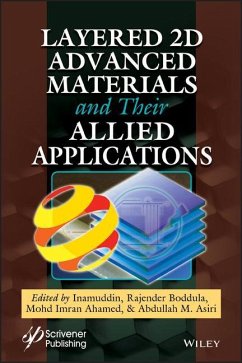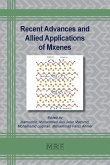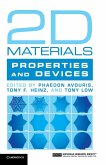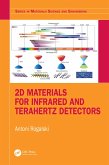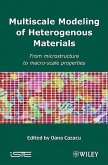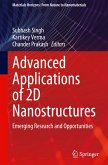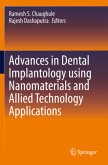Layered 2D Materials and Their Allied Applications
Herausgeber: Inamuddin; Asiri, Abdullah M; Ahamed, Mohd Imran; Boddula, Rajender
Layered 2D Materials and Their Allied Applications
Herausgeber: Inamuddin; Asiri, Abdullah M; Ahamed, Mohd Imran; Boddula, Rajender
- Gebundenes Buch
Andere Kunden interessierten sich auch für
![Recent Advances and Allied Applications of Mxenes Recent Advances and Allied Applications of Mxenes]() Recent Advances and Allied Applications of Mxenes90,99 €
Recent Advances and Allied Applications of Mxenes90,99 €![2D Materials 2D Materials]() 2D Materials100,99 €
2D Materials100,99 €![Functional Two-Dimensional Layered Materials from Graphene to Topological Insulators Functional Two-Dimensional Layered Materials from Graphene to Topological Insulators]() Functional Two-Dimensional Layered Materials from Graphene to Topological Insulators107,99 €
Functional Two-Dimensional Layered Materials from Graphene to Topological Insulators107,99 €![2D Materials for Infrared and Terahertz Detectors 2D Materials for Infrared and Terahertz Detectors]() Antoni Rogalski2D Materials for Infrared and Terahertz Detectors93,99 €
Antoni Rogalski2D Materials for Infrared and Terahertz Detectors93,99 €![Multiscale Modeling of Heterogenous Materials Multiscale Modeling of Heterogenous Materials]() Multiscale Modeling of Heterogenous Materials223,99 €
Multiscale Modeling of Heterogenous Materials223,99 €![Advanced Applications of 2D Nanostructures Advanced Applications of 2D Nanostructures]() Advanced Applications of 2D Nanostructures117,99 €
Advanced Applications of 2D Nanostructures117,99 €![Advances in Dental Implantology using Nanomaterials and Allied Technology Applications Advances in Dental Implantology using Nanomaterials and Allied Technology Applications]() Advances in Dental Implantology using Nanomaterials and Allied Technology Applications74,99 €
Advances in Dental Implantology using Nanomaterials and Allied Technology Applications74,99 €-
-
-
Produktdetails
- Verlag: Wiley
- Seitenzahl: 400
- Erscheinungstermin: 23. Juni 2020
- Englisch
- Abmessung: 229mm x 152mm x 22mm
- Gewicht: 703g
- ISBN-13: 9781119654964
- ISBN-10: 1119654963
- Artikelnr.: 58408287
Hinweis: Dieser Artikel kann nur an eine deutsche Lieferadresse ausgeliefert werden.
- Herstellerkennzeichnung
- Libri GmbH
- Europaallee 1
- 36244 Bad Hersfeld
- 06621 890
Inamuddin, PhD, is an assistant professor at King Abdulaziz University, Jeddah, Saudi Arabia and is also an assistant professor in the Department of Applied Chemistry, Aligarh Muslim University, Aligarh, India. He has extensive research experience in multidisciplinary fields of analytical chemistry, materials chemistry, electrochemistry, renewable energy and environmental science. He has published about 150 research articles in various international scientific journals, 18 book chapters, and 60 edited books with multiple well-known publishers. Rajender Boddula, PhD, is currently working for the Chinese Academy of Sciences President's International Fellowship Initiative (CAS-PIFI) at the National Center for Nanoscience and Technology (NCNST, Beijing). His academic honors include multiple fellowships and scholarships, and he has published many scientific articles in international peer-reviewed journals, edited books with numerous publishers and has authored twenty book chapters. Mohd Imran Ahamed received his Ph.D on the topic "Synthesis and characterization of inorganic-organic composite heavy metals selective cation-exchangers and their analytical applications", from Aligarh Muslim University, India in 2019. He has published several research and review articles in SCI journals. His research focusses on ion-exchange chromatography, wastewater treatment and analysis, actuators and electrospinning. Abdullah M. Asiri is the Head of the Chemistry Department at King Abdulaziz University and the founder and Director of the Center of Excellence for Advanced Materials Research (CEAMR). He is the Editor-in-Chief of the King Abdulaziz University Journal of Science. He has received numerous awards, including the first prize for distinction in science from the Saudi Chemical Society in 2012. He holds multiple patents, has authored ten books and more than one thousand publications in international journals.
Preface xv
1 2D Metal-Organic Frameworks 1
Fengxian Cao, Jian Chen, Qixun Xia and Xinglai Zhang
1.1 Introduction 1
1.2 Synthesis Approaches 2
1.2.1 Selection of Synthetic Raw Materials 3
1.2.2 Solvent Volatility Method 4
1.2.3 Diffusion Method 4
1.2.3.1 Gas Phase Diffusion 4
1.2.3.2 Liquid Phase Diffusion 4
1.2.4 Sol-Gel Method 5
1.2.5 Hydrothermal/Solvothermal Synthesis Method 6
1.2.6 Stripping Method 6
1.2.7 Microwave Synthesis Method 8
1.2.8 Self-Assembly 9
1.2.9 Special Interface Synthesis Method 9
1.2.10 Surfactant-Assisted Synthesis Method 10
1.2.11 Ultrasonic Synthesis 10
1.3 Structures, Properties, and Applications 11
1.3.1 Structure and Properties of MOFs 11
1.3.2 Application in Biomedicine 12
1.3.3 Application in Gas Storage 12
1.3.4 Application in Sensors 13
1.3.5 Application in Chemical Separation 13
1.3.6 Application in Catalysis 14
1.3.7 Application in Gas Adsorption 14
1.4 Summary and Outlook 15
Acknowledgements 16
References 16
2 2D Black Phosphorus 21
Chenguang Duan, Hui Qiao, Zongyut Huang and Xiang Qi
2.1 Introduction 22
2.2 The Research on Black Phosphorus 23
2.2.1 The Structure and Properties 23
2.2.1.1 The Structure of Black Phosphorus 25
2.2.1.2 The Properties of Black Phosphorus 25
2.2.2 Preparation Methods 26
2.2.2.1 Mechanical Exfoliation 28
2.2.2.2 Liquid-Phase Exfoliation 28
2.2.3 Antioxidant 30
2.2.3.1 Degradation Mechanism 30
2.2.3.2 Adding Protective Layer 31
2.2.3.3 Chemical Modification 31
2.2.3.4 Doping 33
2.3 Applications of Black Phosphorus 33
2.3.1 Electronic and Optoelectronic 34
2.3.1.1 Field-Effect Transistors 34
2.3.1.2 Photodetector 35
2.3.2 Energy Storage and Conversion 36
2.3.2.1 Catalysis 36
2.3.2.2 Batteries 37
2.3.2.3 Supercapacitor 38
2.3.3 Biomedical 39
2.4 Conclusion and Outlook 40
Acknowledgements 41
References 41
3 2D Metal Carbides 47
Peiran Hou, Xinxin Fu, Qixun Xia and Zhengpeng Yang
3.1 Introduction 47
3.2 Synthesis Approaches 48
3.2.1 Ti3C2 Synthesis 48
3.2.2 V2C Synthesis 50
3.2.3 Ti2C Synthesis 50
3.2.4 Mo2C Synthesis 51
3.3 Structures, Properties, and Applications 52
3.3.1 Structures and Properties of 2D Metal Carbides 52
3.3.1.1 Structures and Properties of Ti3C2 52
3.3.1.2 Structural Properties of Ti2C 53
3.3.1.3 Structural Properties of Mo2C 53
3.3.1.4 Structural Properties of V2C 54
3.3.2 Carbide Materials in Energy Storage Applications 55
3.3.2.1 Ti3C2 56
3.3.2.2 Ti2C 57
3.3.2.3 V2C 58
3.3.2.4 Mo2C 58
3.3.3 Metal Carbide Materials in Catalysis Applications 60
3.3.3.1 Ti3C2 60
3.3.3.2 V2C 61
3.3.3.3 Mo2C 62
3.3.4 Metal Carbide Materials in Environmental Management Applications 63
3.3.4.1 Ti3C2 in Environmental Management Applications 63
3.3.4.2 Ti2C in Environmental Management Applications 64
3.3.4.3 V2C in Environmental Management Applications 64
3.3.4.4 Mo2C in Environmental Management Applications 65
3.3.5 Carbide Materials in Biomedicine Applications 66
3.3.5.1 Ti3C2 in Biomedicine Applications 66
3.3.5.2 Ti2C in Biomedicine Applications 66
3.3.5.3 V2C in Biomedicine Applications 68
3.3.5.4 Mo2C in Biomedicine Applications 68
3.3.6 Carbide Materials in Gas Sensing Applications 69
3.3.6.1 Ti3C2 in Gas Sensing Applications 69
3.3.6.2 Ti2C in Gas Sensing Applications 69
3.3.6.3 V2C in Gas Sensing Applications 70
3.3.6.4 Mo2C in Gas Sensing Applications 71
3.4 Summary and Outlook 72
Acknowledgements 72
References 73
4 2D Carbon Materials as Photocatalysts 79
Amel Boudjemaa
4.1 Introduction 79
4.2 Carbon Nanostructured-Based Materials 80
4.2.1 Forms of Carbon 80
4.2.2 Synthesis of Carbon Nanostructured-Based Materials 80
4.3 Photo-Degradation of Organic Pollutants 81
4.3.1 Graphene, Graphene Oxide, Graphene Nitride (g-C3N4) 81
4.3.1.1 Graphene-Based Materials 82
4.3.1.2 Graphene Nitride (g-C3N4) 84
4.3.2 Carbon Dots (CDs) 87
4.3.3 Carbon Spheres (CSs) 87
4.4 Carbon-Based Materials for Hydrogen Production 88
4.5 Carbon-Based Materials for CO2 Reduction 90
References 90
5 Sensitivity Analysis of Surface Plasmon Resonance Biosensor Based on
Heterostructure of 2D BlueP/MoS2 and MXene 103
Sarika Pal, Narendra Pal, Y.K. Prajapati and J.P. Saini
5.1 Introduction 104
5.2 Proposed SPR Sensor, Design Considerations, and Modeling 107
5.2.1 SPR Sensor and Its Sensing Principle 107
5.2.2 Design Consideration 108
5.2.2.1 Layer 1: Prism for Light Coupling 108
5.2.2.2 Layer 2: Metal Layer 109
5.2.2.3 Layer 3: BlueP/MoS2 Layer 110
5.2.2.4 Layer 4: MXene (Ti3C2Tx) Layer as BRE for Biosensing 110
5.2.2.5 Layer 5: Sensing Medium (RI-1.33-1.335) 110
5.2.3 Proposed Sensor Modeling 110
5.3 Results Discussion 112
5.3.1 Role of Monolayer BlueP/MoS2 and MXene (Ti3C2Tx) and Its Comparison
With Conventional SPR 112
5.3.2 Influence of Varying Heterostructure Layers for Proposed Design 114
5.3.3 Effect of Changing Prism Material and Metal on Performance of
Proposed Design 115
5.4 Conclusion 125
References 125
6 2D Perovskite Materials and Their Device Applications 131
B. Venkata Shiva Reddy, K. Srinivas, N. Suresh Kumar, S. Ramesh, K. Chandra
Babu Naidu, Prasun Banerjee, Ramyakrishna Pothu and Rajender Boddula
6.1 Introduction 131
6.2 Structure 134
6.2.1 Crystal Structure 134
6.2.2 Electronic Structure of 2D Perovskites 134
6.2.3 Structure of Photovoltaic Cell 135
6.3 Discussion and Applications 136
6.4 Conclusion 139
References 139
7 Introduction and Significant Parameters for Layered Materials 141
Umbreen Rasheed, Fayyaz Hussain, Muhammad Imran, R.M. Arif Khalil and
Sungjun Kim
7.1 Graphene 143
7.2 Phosphorene 147
7.3 Silicene 148
7.4 ZnO 150
7.5 Transition Metal Dichalcogenides (TMDCs) 151
7.6 Germanene and Stanene 152
7.7 Heterostructures 153
References 156
8 Increment in Photocatalytic Activity of g-C3N4 Coupled Sulphides and
Oxides for Environmental Remediation 159
Pankaj Raizada, Abhinadan Kumar and Pardeep Singh
8.1 Introduction 160
8.2 GCN Coupled Metal Sulphide Heterojunctions for Environment Remediation
163
8.2.1 GCN and MoS2-Based Photocatalysts 163
8.2.2 GCN and CdS-Based Heterojunctions 168
8.2.3 Some Other GCN Coupled Metal Sulphide Photocatalysts 171
8.3 GCN Coupled Metal Oxide Heterojunctions for Environment Remediation 173
8.3.1 GCN and MoO3-Based Heterojunctions 177
8.3.2 GCN and Fe2O3-Based Heterojunctions 179
8.3.3 Some Other GCN Coupled Metal Oxide Photocatalysts 180
8.4 Conclusions and Outlook 181
References 181
9 2D Zeolites 193
Moumita Sardar, Manisha Maharana, Madhumita Manna and Sujit Sen
9.1 Introduction 193
9.1.1 What is 2D Zeolite? 195
9.1.2 Advancement in Zeolites to 2D Zeolite 196
9.2 Synthetic Method 197
9.2.1 Bottom-Up Method 197
9.2.2 Top-Down Method 198
9.2.3 Support-Assisted Method 199
9.2.4 Post-Synthesis Modification of 2D Zeolites 200
9.3 Properties 200
9.4 Applications 203
9.4.1 Petro-Chemistry 203
9.4.2 Biomass Conversion 203
9.4.2.1 Pyrolysis of Solid Biomass 203
9.4.2.2 Condensation Reactions 204
9.4.2.3 Isomerization 204
9.4.2.4 Dehydration Reactions 204
9.4.3 Oxidation Reactions 205
9.4.4 Fine Chemical Synthesis 206
9.4.5 Organometallics 206
9.5 Conclusion 206
References 207
10 2D Hollow Nanomaterials 211
S.S. Athira, V. Akhil, X. Joseph , J. Ashtami and P.V. Mohanan
10.1 Introduction 212
10.2 Structural Aspects of HNMs 213
10.3 Synthetic Approaches 214
10.3.1 Template-Based Strategies 215
10.3.1.1 Hard Templating 215
10.3.1.2 Soft Templating 217
10.3.2 Self-Templating Strategies 218
10.3.2.1 Surface Protected Etching 219
10.3.2.2 Ostwald Ripening 219
10.3.2.3 Kirkendall Effect 219
10.3.2.4 Galvanic Replacement 220
10.4 Medical Applications of HNMs 220
10.4.1 Imaging and Diagnosis Applications 221
10.4.2 Applications of Nanotube Arrays 222
10.4.2.1 Pharmacy and Medicine 224
10.4.2.2 Cancer Therapy 224
10.4.2.3 Immuno and Hyperthermia Therapy 226
10.4.2.4 Infection Therapy and Gene Therapy 226
10.4.3 Hollow Nanomaterials in Diagnostics and Therapeutics 227
10.4.4 Applications in Regenerative Medicine 227
10.4.5 Anti-Neurodegenerative Applications 228
10.4.6 Photothermal Therapy 229
10.4.7 Biosensors 230
10.5 Non-Medical Applications of HNMs 231
10.5.1 Catalytic Micro or Nanoreactors 231
10.5.2 Energy Storage 232
10.5.2.1 Lithium Ion Battery 232
10.5.2.2 Supercapacitor 232
10.5.3 Nanosensors 233
10.5.4 Wastewater Treatment 234
10.6 Toxicity of 2D HNMs 234
10.7 Future Challenges 237
10.8 Conclusion 239
Acknowledgement 240
References 240
11 2D Layered Double Hydroxides 249
J. Ashtami, X. Joseph, V. Akhil , S.S. Athira and P.V. Mohanan
11.1 Introduction 250
11.2 Structural Aspects 251
11.3 Synthesis of LDHs 252
11.3.1 Co-Precipitation Method 253
11.3.2 Urea Hydrolysis 254
11.3.3 Ion-Exchange Method 254
11.3.4 Reconstruction Method 254
11.3.5 Hydrothermal Method 255
11.3.6 Sol-Gel Method 255
11.4 Nonmedical Applications of LDH 255
11.4.1 Adsorbent 255
11.4.2 Catalyst 257
11.4.3 Sensors 260
11.4.4 Electrode 261
11.4.5 Polymer Additive 261
11.4.6 Anion Scavenger 262
11.4.7 Flame Retardant 263
11.5 Biomedical Applications 263
11.5.1 Biosensors 263
11.5.2 Scaffolds 265
11.5.3 Anti-Microbial Agents 266
11.5.4 Drug Delivery 267
11.5.5 Imaging 269
11.5.6 Protein Purification 269
11.5.7 Gene Delivery 270
11.6 Toxicity 272
11.7 Conclusion 273
Acknowledgement 274
References 274
12 Experimental Techniques for Layered Materials 283
Tariq Munir, Arslan Mahmood, Muhammad Imran, Muhammad Kashif, Amjad Sohail,
Zeeshan Yaqoob, Aleena Manzoor and Fahad Shafiq
12.1 Introduction 284
12.2 Methods for Synthesis of Graphene Layered Materials 285
12.3 Selection of a Suitable Metallic Substrate 287
12.4 Graphene Synthesis by HFTCVD 287
12.5 Graphene Transfer 289
12.6 Characterization Techniques 291
12.6.1 X-Ray Diffraction Technique 291
12.6.2 Field Emission Scanning Electron Microscopy (FESEM) 292
12.6.3 Transmission Electron Microscopy (TEM) 293
12.6.4 Fourier Transform Infrared Radiation (FTIR) 294
12.6.5 UV-Visible Spectroscopy 295
12.6.6 Raman Spectroscopy 295
12.6.7 Low Energy Electron Microscopy (LEEM) 296
12.7 Potential Applications of Graphene and Derived Materials 297
12.8 Conclusion 298
Acknowledgement 298
References 299
13 Two-Dimensional Hexagonal Boron Nitride and Borophenes 303
Atif Suhail and Indranil Lahiri
13.1 Two-Dimensional Hexagonal Boron Nitride (2D h-BN): An Introduction 304
13.2 Properties of 2D h-BN 305
13.2.1 Structural Properties 305
13.2.2 Electronic and Dielectric Properties 306
13.2.3 Optical Properties 307
13.3 Synthesis Methods of 2D h-BN 308
13.3.1 Mechanical Exfoliation 309
13.3.2 Liquid Exfoliation 310
13.3.3 Chemical Vapor Deposition (CVD) 310
13.3.3.1 Synthesis Parameters 312
13.3.3.2 Growth Mechanism 313
13.3.3.3 Transfer of 2D h-BN Onto Other Substrates 314
13.3.4 Physical Vapor Deposition Method (PVD) 315
13.3.5 Surface Segregation Method 316
13.4 Application of 2D h-BN 317
13.4.1 2D h-BN in Electronic Manufacturing 318
13.4.2 2D h-BN as a Filler in Polymer Composites 319
13.4.3 2D h-BN as a Protective Barrier 320
13.4.4 2D h-BN in Optoelectronics 321
13.5 Borophene 323
13.5.1 Theoretical Investigation and Experimental Synthesis 324
13.5.2 Properties and Application of Borophene 326
13.5.2.1 Electronic Properties of Borophene 326
13.5.2.2 Chemical Properties 326
13.5.3 Potential Applications of Borophene 328
References 328
14 Transition-Metal Dichalcogenides for Photoelectrochemical Hydrogen
Evolution Reaction 337
Rozan Mohamad Yunus, Mohd Nur Ikhmal Salehmin and Nurul Nabila Rosman
14.1 Introduction 337
14.2 TMDC-Based Photoactive Materials for HER 339
14.2.1 MoS2 339
14.2.2 MoSe2 341
14.2.3 WS2 341
14.2.4 CoSe2 342
14.2.5 FeS2 343
14.2.6 NiSe2 344
14.3 TMDCs Fabrication Methods 345
14.3.1 Hydrothermal 345
14.3.2 Chemical Vapor Deposition/Vapor Phase Growth Process 346
14.3.3 Metal-Organic Chemical Vapor Deposition (MOCVD) 347
14.3.4 Atomic Layer Deposition (ALD) 348
14.4 Current Photocatalytic Activity Performance 350
14.5 Summary and Perspective 351
References 352
15 State-of-the-Art and Perspective of Layered Materials 363
Tariq Munir, Muhammad Kashif, Aamir Shahzad, Nadeem Nasir, Muhammad Imran,
Nabeel Anjum and Arslan Mahmood
15.1 Introduction 363
15.2 State-of-the-Art and Future Perspective 364
15.2.1 Electronic Devices 365
15.2.2 Optoelectronic Devices 369
15.2.3 Energy Storage Devices 372
15.3 Conclusion 374
References 374
Index 379
1 2D Metal-Organic Frameworks 1
Fengxian Cao, Jian Chen, Qixun Xia and Xinglai Zhang
1.1 Introduction 1
1.2 Synthesis Approaches 2
1.2.1 Selection of Synthetic Raw Materials 3
1.2.2 Solvent Volatility Method 4
1.2.3 Diffusion Method 4
1.2.3.1 Gas Phase Diffusion 4
1.2.3.2 Liquid Phase Diffusion 4
1.2.4 Sol-Gel Method 5
1.2.5 Hydrothermal/Solvothermal Synthesis Method 6
1.2.6 Stripping Method 6
1.2.7 Microwave Synthesis Method 8
1.2.8 Self-Assembly 9
1.2.9 Special Interface Synthesis Method 9
1.2.10 Surfactant-Assisted Synthesis Method 10
1.2.11 Ultrasonic Synthesis 10
1.3 Structures, Properties, and Applications 11
1.3.1 Structure and Properties of MOFs 11
1.3.2 Application in Biomedicine 12
1.3.3 Application in Gas Storage 12
1.3.4 Application in Sensors 13
1.3.5 Application in Chemical Separation 13
1.3.6 Application in Catalysis 14
1.3.7 Application in Gas Adsorption 14
1.4 Summary and Outlook 15
Acknowledgements 16
References 16
2 2D Black Phosphorus 21
Chenguang Duan, Hui Qiao, Zongyut Huang and Xiang Qi
2.1 Introduction 22
2.2 The Research on Black Phosphorus 23
2.2.1 The Structure and Properties 23
2.2.1.1 The Structure of Black Phosphorus 25
2.2.1.2 The Properties of Black Phosphorus 25
2.2.2 Preparation Methods 26
2.2.2.1 Mechanical Exfoliation 28
2.2.2.2 Liquid-Phase Exfoliation 28
2.2.3 Antioxidant 30
2.2.3.1 Degradation Mechanism 30
2.2.3.2 Adding Protective Layer 31
2.2.3.3 Chemical Modification 31
2.2.3.4 Doping 33
2.3 Applications of Black Phosphorus 33
2.3.1 Electronic and Optoelectronic 34
2.3.1.1 Field-Effect Transistors 34
2.3.1.2 Photodetector 35
2.3.2 Energy Storage and Conversion 36
2.3.2.1 Catalysis 36
2.3.2.2 Batteries 37
2.3.2.3 Supercapacitor 38
2.3.3 Biomedical 39
2.4 Conclusion and Outlook 40
Acknowledgements 41
References 41
3 2D Metal Carbides 47
Peiran Hou, Xinxin Fu, Qixun Xia and Zhengpeng Yang
3.1 Introduction 47
3.2 Synthesis Approaches 48
3.2.1 Ti3C2 Synthesis 48
3.2.2 V2C Synthesis 50
3.2.3 Ti2C Synthesis 50
3.2.4 Mo2C Synthesis 51
3.3 Structures, Properties, and Applications 52
3.3.1 Structures and Properties of 2D Metal Carbides 52
3.3.1.1 Structures and Properties of Ti3C2 52
3.3.1.2 Structural Properties of Ti2C 53
3.3.1.3 Structural Properties of Mo2C 53
3.3.1.4 Structural Properties of V2C 54
3.3.2 Carbide Materials in Energy Storage Applications 55
3.3.2.1 Ti3C2 56
3.3.2.2 Ti2C 57
3.3.2.3 V2C 58
3.3.2.4 Mo2C 58
3.3.3 Metal Carbide Materials in Catalysis Applications 60
3.3.3.1 Ti3C2 60
3.3.3.2 V2C 61
3.3.3.3 Mo2C 62
3.3.4 Metal Carbide Materials in Environmental Management Applications 63
3.3.4.1 Ti3C2 in Environmental Management Applications 63
3.3.4.2 Ti2C in Environmental Management Applications 64
3.3.4.3 V2C in Environmental Management Applications 64
3.3.4.4 Mo2C in Environmental Management Applications 65
3.3.5 Carbide Materials in Biomedicine Applications 66
3.3.5.1 Ti3C2 in Biomedicine Applications 66
3.3.5.2 Ti2C in Biomedicine Applications 66
3.3.5.3 V2C in Biomedicine Applications 68
3.3.5.4 Mo2C in Biomedicine Applications 68
3.3.6 Carbide Materials in Gas Sensing Applications 69
3.3.6.1 Ti3C2 in Gas Sensing Applications 69
3.3.6.2 Ti2C in Gas Sensing Applications 69
3.3.6.3 V2C in Gas Sensing Applications 70
3.3.6.4 Mo2C in Gas Sensing Applications 71
3.4 Summary and Outlook 72
Acknowledgements 72
References 73
4 2D Carbon Materials as Photocatalysts 79
Amel Boudjemaa
4.1 Introduction 79
4.2 Carbon Nanostructured-Based Materials 80
4.2.1 Forms of Carbon 80
4.2.2 Synthesis of Carbon Nanostructured-Based Materials 80
4.3 Photo-Degradation of Organic Pollutants 81
4.3.1 Graphene, Graphene Oxide, Graphene Nitride (g-C3N4) 81
4.3.1.1 Graphene-Based Materials 82
4.3.1.2 Graphene Nitride (g-C3N4) 84
4.3.2 Carbon Dots (CDs) 87
4.3.3 Carbon Spheres (CSs) 87
4.4 Carbon-Based Materials for Hydrogen Production 88
4.5 Carbon-Based Materials for CO2 Reduction 90
References 90
5 Sensitivity Analysis of Surface Plasmon Resonance Biosensor Based on
Heterostructure of 2D BlueP/MoS2 and MXene 103
Sarika Pal, Narendra Pal, Y.K. Prajapati and J.P. Saini
5.1 Introduction 104
5.2 Proposed SPR Sensor, Design Considerations, and Modeling 107
5.2.1 SPR Sensor and Its Sensing Principle 107
5.2.2 Design Consideration 108
5.2.2.1 Layer 1: Prism for Light Coupling 108
5.2.2.2 Layer 2: Metal Layer 109
5.2.2.3 Layer 3: BlueP/MoS2 Layer 110
5.2.2.4 Layer 4: MXene (Ti3C2Tx) Layer as BRE for Biosensing 110
5.2.2.5 Layer 5: Sensing Medium (RI-1.33-1.335) 110
5.2.3 Proposed Sensor Modeling 110
5.3 Results Discussion 112
5.3.1 Role of Monolayer BlueP/MoS2 and MXene (Ti3C2Tx) and Its Comparison
With Conventional SPR 112
5.3.2 Influence of Varying Heterostructure Layers for Proposed Design 114
5.3.3 Effect of Changing Prism Material and Metal on Performance of
Proposed Design 115
5.4 Conclusion 125
References 125
6 2D Perovskite Materials and Their Device Applications 131
B. Venkata Shiva Reddy, K. Srinivas, N. Suresh Kumar, S. Ramesh, K. Chandra
Babu Naidu, Prasun Banerjee, Ramyakrishna Pothu and Rajender Boddula
6.1 Introduction 131
6.2 Structure 134
6.2.1 Crystal Structure 134
6.2.2 Electronic Structure of 2D Perovskites 134
6.2.3 Structure of Photovoltaic Cell 135
6.3 Discussion and Applications 136
6.4 Conclusion 139
References 139
7 Introduction and Significant Parameters for Layered Materials 141
Umbreen Rasheed, Fayyaz Hussain, Muhammad Imran, R.M. Arif Khalil and
Sungjun Kim
7.1 Graphene 143
7.2 Phosphorene 147
7.3 Silicene 148
7.4 ZnO 150
7.5 Transition Metal Dichalcogenides (TMDCs) 151
7.6 Germanene and Stanene 152
7.7 Heterostructures 153
References 156
8 Increment in Photocatalytic Activity of g-C3N4 Coupled Sulphides and
Oxides for Environmental Remediation 159
Pankaj Raizada, Abhinadan Kumar and Pardeep Singh
8.1 Introduction 160
8.2 GCN Coupled Metal Sulphide Heterojunctions for Environment Remediation
163
8.2.1 GCN and MoS2-Based Photocatalysts 163
8.2.2 GCN and CdS-Based Heterojunctions 168
8.2.3 Some Other GCN Coupled Metal Sulphide Photocatalysts 171
8.3 GCN Coupled Metal Oxide Heterojunctions for Environment Remediation 173
8.3.1 GCN and MoO3-Based Heterojunctions 177
8.3.2 GCN and Fe2O3-Based Heterojunctions 179
8.3.3 Some Other GCN Coupled Metal Oxide Photocatalysts 180
8.4 Conclusions and Outlook 181
References 181
9 2D Zeolites 193
Moumita Sardar, Manisha Maharana, Madhumita Manna and Sujit Sen
9.1 Introduction 193
9.1.1 What is 2D Zeolite? 195
9.1.2 Advancement in Zeolites to 2D Zeolite 196
9.2 Synthetic Method 197
9.2.1 Bottom-Up Method 197
9.2.2 Top-Down Method 198
9.2.3 Support-Assisted Method 199
9.2.4 Post-Synthesis Modification of 2D Zeolites 200
9.3 Properties 200
9.4 Applications 203
9.4.1 Petro-Chemistry 203
9.4.2 Biomass Conversion 203
9.4.2.1 Pyrolysis of Solid Biomass 203
9.4.2.2 Condensation Reactions 204
9.4.2.3 Isomerization 204
9.4.2.4 Dehydration Reactions 204
9.4.3 Oxidation Reactions 205
9.4.4 Fine Chemical Synthesis 206
9.4.5 Organometallics 206
9.5 Conclusion 206
References 207
10 2D Hollow Nanomaterials 211
S.S. Athira, V. Akhil, X. Joseph , J. Ashtami and P.V. Mohanan
10.1 Introduction 212
10.2 Structural Aspects of HNMs 213
10.3 Synthetic Approaches 214
10.3.1 Template-Based Strategies 215
10.3.1.1 Hard Templating 215
10.3.1.2 Soft Templating 217
10.3.2 Self-Templating Strategies 218
10.3.2.1 Surface Protected Etching 219
10.3.2.2 Ostwald Ripening 219
10.3.2.3 Kirkendall Effect 219
10.3.2.4 Galvanic Replacement 220
10.4 Medical Applications of HNMs 220
10.4.1 Imaging and Diagnosis Applications 221
10.4.2 Applications of Nanotube Arrays 222
10.4.2.1 Pharmacy and Medicine 224
10.4.2.2 Cancer Therapy 224
10.4.2.3 Immuno and Hyperthermia Therapy 226
10.4.2.4 Infection Therapy and Gene Therapy 226
10.4.3 Hollow Nanomaterials in Diagnostics and Therapeutics 227
10.4.4 Applications in Regenerative Medicine 227
10.4.5 Anti-Neurodegenerative Applications 228
10.4.6 Photothermal Therapy 229
10.4.7 Biosensors 230
10.5 Non-Medical Applications of HNMs 231
10.5.1 Catalytic Micro or Nanoreactors 231
10.5.2 Energy Storage 232
10.5.2.1 Lithium Ion Battery 232
10.5.2.2 Supercapacitor 232
10.5.3 Nanosensors 233
10.5.4 Wastewater Treatment 234
10.6 Toxicity of 2D HNMs 234
10.7 Future Challenges 237
10.8 Conclusion 239
Acknowledgement 240
References 240
11 2D Layered Double Hydroxides 249
J. Ashtami, X. Joseph, V. Akhil , S.S. Athira and P.V. Mohanan
11.1 Introduction 250
11.2 Structural Aspects 251
11.3 Synthesis of LDHs 252
11.3.1 Co-Precipitation Method 253
11.3.2 Urea Hydrolysis 254
11.3.3 Ion-Exchange Method 254
11.3.4 Reconstruction Method 254
11.3.5 Hydrothermal Method 255
11.3.6 Sol-Gel Method 255
11.4 Nonmedical Applications of LDH 255
11.4.1 Adsorbent 255
11.4.2 Catalyst 257
11.4.3 Sensors 260
11.4.4 Electrode 261
11.4.5 Polymer Additive 261
11.4.6 Anion Scavenger 262
11.4.7 Flame Retardant 263
11.5 Biomedical Applications 263
11.5.1 Biosensors 263
11.5.2 Scaffolds 265
11.5.3 Anti-Microbial Agents 266
11.5.4 Drug Delivery 267
11.5.5 Imaging 269
11.5.6 Protein Purification 269
11.5.7 Gene Delivery 270
11.6 Toxicity 272
11.7 Conclusion 273
Acknowledgement 274
References 274
12 Experimental Techniques for Layered Materials 283
Tariq Munir, Arslan Mahmood, Muhammad Imran, Muhammad Kashif, Amjad Sohail,
Zeeshan Yaqoob, Aleena Manzoor and Fahad Shafiq
12.1 Introduction 284
12.2 Methods for Synthesis of Graphene Layered Materials 285
12.3 Selection of a Suitable Metallic Substrate 287
12.4 Graphene Synthesis by HFTCVD 287
12.5 Graphene Transfer 289
12.6 Characterization Techniques 291
12.6.1 X-Ray Diffraction Technique 291
12.6.2 Field Emission Scanning Electron Microscopy (FESEM) 292
12.6.3 Transmission Electron Microscopy (TEM) 293
12.6.4 Fourier Transform Infrared Radiation (FTIR) 294
12.6.5 UV-Visible Spectroscopy 295
12.6.6 Raman Spectroscopy 295
12.6.7 Low Energy Electron Microscopy (LEEM) 296
12.7 Potential Applications of Graphene and Derived Materials 297
12.8 Conclusion 298
Acknowledgement 298
References 299
13 Two-Dimensional Hexagonal Boron Nitride and Borophenes 303
Atif Suhail and Indranil Lahiri
13.1 Two-Dimensional Hexagonal Boron Nitride (2D h-BN): An Introduction 304
13.2 Properties of 2D h-BN 305
13.2.1 Structural Properties 305
13.2.2 Electronic and Dielectric Properties 306
13.2.3 Optical Properties 307
13.3 Synthesis Methods of 2D h-BN 308
13.3.1 Mechanical Exfoliation 309
13.3.2 Liquid Exfoliation 310
13.3.3 Chemical Vapor Deposition (CVD) 310
13.3.3.1 Synthesis Parameters 312
13.3.3.2 Growth Mechanism 313
13.3.3.3 Transfer of 2D h-BN Onto Other Substrates 314
13.3.4 Physical Vapor Deposition Method (PVD) 315
13.3.5 Surface Segregation Method 316
13.4 Application of 2D h-BN 317
13.4.1 2D h-BN in Electronic Manufacturing 318
13.4.2 2D h-BN as a Filler in Polymer Composites 319
13.4.3 2D h-BN as a Protective Barrier 320
13.4.4 2D h-BN in Optoelectronics 321
13.5 Borophene 323
13.5.1 Theoretical Investigation and Experimental Synthesis 324
13.5.2 Properties and Application of Borophene 326
13.5.2.1 Electronic Properties of Borophene 326
13.5.2.2 Chemical Properties 326
13.5.3 Potential Applications of Borophene 328
References 328
14 Transition-Metal Dichalcogenides for Photoelectrochemical Hydrogen
Evolution Reaction 337
Rozan Mohamad Yunus, Mohd Nur Ikhmal Salehmin and Nurul Nabila Rosman
14.1 Introduction 337
14.2 TMDC-Based Photoactive Materials for HER 339
14.2.1 MoS2 339
14.2.2 MoSe2 341
14.2.3 WS2 341
14.2.4 CoSe2 342
14.2.5 FeS2 343
14.2.6 NiSe2 344
14.3 TMDCs Fabrication Methods 345
14.3.1 Hydrothermal 345
14.3.2 Chemical Vapor Deposition/Vapor Phase Growth Process 346
14.3.3 Metal-Organic Chemical Vapor Deposition (MOCVD) 347
14.3.4 Atomic Layer Deposition (ALD) 348
14.4 Current Photocatalytic Activity Performance 350
14.5 Summary and Perspective 351
References 352
15 State-of-the-Art and Perspective of Layered Materials 363
Tariq Munir, Muhammad Kashif, Aamir Shahzad, Nadeem Nasir, Muhammad Imran,
Nabeel Anjum and Arslan Mahmood
15.1 Introduction 363
15.2 State-of-the-Art and Future Perspective 364
15.2.1 Electronic Devices 365
15.2.2 Optoelectronic Devices 369
15.2.3 Energy Storage Devices 372
15.3 Conclusion 374
References 374
Index 379
Preface xv
1 2D Metal-Organic Frameworks 1
Fengxian Cao, Jian Chen, Qixun Xia and Xinglai Zhang
1.1 Introduction 1
1.2 Synthesis Approaches 2
1.2.1 Selection of Synthetic Raw Materials 3
1.2.2 Solvent Volatility Method 4
1.2.3 Diffusion Method 4
1.2.3.1 Gas Phase Diffusion 4
1.2.3.2 Liquid Phase Diffusion 4
1.2.4 Sol-Gel Method 5
1.2.5 Hydrothermal/Solvothermal Synthesis Method 6
1.2.6 Stripping Method 6
1.2.7 Microwave Synthesis Method 8
1.2.8 Self-Assembly 9
1.2.9 Special Interface Synthesis Method 9
1.2.10 Surfactant-Assisted Synthesis Method 10
1.2.11 Ultrasonic Synthesis 10
1.3 Structures, Properties, and Applications 11
1.3.1 Structure and Properties of MOFs 11
1.3.2 Application in Biomedicine 12
1.3.3 Application in Gas Storage 12
1.3.4 Application in Sensors 13
1.3.5 Application in Chemical Separation 13
1.3.6 Application in Catalysis 14
1.3.7 Application in Gas Adsorption 14
1.4 Summary and Outlook 15
Acknowledgements 16
References 16
2 2D Black Phosphorus 21
Chenguang Duan, Hui Qiao, Zongyut Huang and Xiang Qi
2.1 Introduction 22
2.2 The Research on Black Phosphorus 23
2.2.1 The Structure and Properties 23
2.2.1.1 The Structure of Black Phosphorus 25
2.2.1.2 The Properties of Black Phosphorus 25
2.2.2 Preparation Methods 26
2.2.2.1 Mechanical Exfoliation 28
2.2.2.2 Liquid-Phase Exfoliation 28
2.2.3 Antioxidant 30
2.2.3.1 Degradation Mechanism 30
2.2.3.2 Adding Protective Layer 31
2.2.3.3 Chemical Modification 31
2.2.3.4 Doping 33
2.3 Applications of Black Phosphorus 33
2.3.1 Electronic and Optoelectronic 34
2.3.1.1 Field-Effect Transistors 34
2.3.1.2 Photodetector 35
2.3.2 Energy Storage and Conversion 36
2.3.2.1 Catalysis 36
2.3.2.2 Batteries 37
2.3.2.3 Supercapacitor 38
2.3.3 Biomedical 39
2.4 Conclusion and Outlook 40
Acknowledgements 41
References 41
3 2D Metal Carbides 47
Peiran Hou, Xinxin Fu, Qixun Xia and Zhengpeng Yang
3.1 Introduction 47
3.2 Synthesis Approaches 48
3.2.1 Ti3C2 Synthesis 48
3.2.2 V2C Synthesis 50
3.2.3 Ti2C Synthesis 50
3.2.4 Mo2C Synthesis 51
3.3 Structures, Properties, and Applications 52
3.3.1 Structures and Properties of 2D Metal Carbides 52
3.3.1.1 Structures and Properties of Ti3C2 52
3.3.1.2 Structural Properties of Ti2C 53
3.3.1.3 Structural Properties of Mo2C 53
3.3.1.4 Structural Properties of V2C 54
3.3.2 Carbide Materials in Energy Storage Applications 55
3.3.2.1 Ti3C2 56
3.3.2.2 Ti2C 57
3.3.2.3 V2C 58
3.3.2.4 Mo2C 58
3.3.3 Metal Carbide Materials in Catalysis Applications 60
3.3.3.1 Ti3C2 60
3.3.3.2 V2C 61
3.3.3.3 Mo2C 62
3.3.4 Metal Carbide Materials in Environmental Management Applications 63
3.3.4.1 Ti3C2 in Environmental Management Applications 63
3.3.4.2 Ti2C in Environmental Management Applications 64
3.3.4.3 V2C in Environmental Management Applications 64
3.3.4.4 Mo2C in Environmental Management Applications 65
3.3.5 Carbide Materials in Biomedicine Applications 66
3.3.5.1 Ti3C2 in Biomedicine Applications 66
3.3.5.2 Ti2C in Biomedicine Applications 66
3.3.5.3 V2C in Biomedicine Applications 68
3.3.5.4 Mo2C in Biomedicine Applications 68
3.3.6 Carbide Materials in Gas Sensing Applications 69
3.3.6.1 Ti3C2 in Gas Sensing Applications 69
3.3.6.2 Ti2C in Gas Sensing Applications 69
3.3.6.3 V2C in Gas Sensing Applications 70
3.3.6.4 Mo2C in Gas Sensing Applications 71
3.4 Summary and Outlook 72
Acknowledgements 72
References 73
4 2D Carbon Materials as Photocatalysts 79
Amel Boudjemaa
4.1 Introduction 79
4.2 Carbon Nanostructured-Based Materials 80
4.2.1 Forms of Carbon 80
4.2.2 Synthesis of Carbon Nanostructured-Based Materials 80
4.3 Photo-Degradation of Organic Pollutants 81
4.3.1 Graphene, Graphene Oxide, Graphene Nitride (g-C3N4) 81
4.3.1.1 Graphene-Based Materials 82
4.3.1.2 Graphene Nitride (g-C3N4) 84
4.3.2 Carbon Dots (CDs) 87
4.3.3 Carbon Spheres (CSs) 87
4.4 Carbon-Based Materials for Hydrogen Production 88
4.5 Carbon-Based Materials for CO2 Reduction 90
References 90
5 Sensitivity Analysis of Surface Plasmon Resonance Biosensor Based on
Heterostructure of 2D BlueP/MoS2 and MXene 103
Sarika Pal, Narendra Pal, Y.K. Prajapati and J.P. Saini
5.1 Introduction 104
5.2 Proposed SPR Sensor, Design Considerations, and Modeling 107
5.2.1 SPR Sensor and Its Sensing Principle 107
5.2.2 Design Consideration 108
5.2.2.1 Layer 1: Prism for Light Coupling 108
5.2.2.2 Layer 2: Metal Layer 109
5.2.2.3 Layer 3: BlueP/MoS2 Layer 110
5.2.2.4 Layer 4: MXene (Ti3C2Tx) Layer as BRE for Biosensing 110
5.2.2.5 Layer 5: Sensing Medium (RI-1.33-1.335) 110
5.2.3 Proposed Sensor Modeling 110
5.3 Results Discussion 112
5.3.1 Role of Monolayer BlueP/MoS2 and MXene (Ti3C2Tx) and Its Comparison
With Conventional SPR 112
5.3.2 Influence of Varying Heterostructure Layers for Proposed Design 114
5.3.3 Effect of Changing Prism Material and Metal on Performance of
Proposed Design 115
5.4 Conclusion 125
References 125
6 2D Perovskite Materials and Their Device Applications 131
B. Venkata Shiva Reddy, K. Srinivas, N. Suresh Kumar, S. Ramesh, K. Chandra
Babu Naidu, Prasun Banerjee, Ramyakrishna Pothu and Rajender Boddula
6.1 Introduction 131
6.2 Structure 134
6.2.1 Crystal Structure 134
6.2.2 Electronic Structure of 2D Perovskites 134
6.2.3 Structure of Photovoltaic Cell 135
6.3 Discussion and Applications 136
6.4 Conclusion 139
References 139
7 Introduction and Significant Parameters for Layered Materials 141
Umbreen Rasheed, Fayyaz Hussain, Muhammad Imran, R.M. Arif Khalil and
Sungjun Kim
7.1 Graphene 143
7.2 Phosphorene 147
7.3 Silicene 148
7.4 ZnO 150
7.5 Transition Metal Dichalcogenides (TMDCs) 151
7.6 Germanene and Stanene 152
7.7 Heterostructures 153
References 156
8 Increment in Photocatalytic Activity of g-C3N4 Coupled Sulphides and
Oxides for Environmental Remediation 159
Pankaj Raizada, Abhinadan Kumar and Pardeep Singh
8.1 Introduction 160
8.2 GCN Coupled Metal Sulphide Heterojunctions for Environment Remediation
163
8.2.1 GCN and MoS2-Based Photocatalysts 163
8.2.2 GCN and CdS-Based Heterojunctions 168
8.2.3 Some Other GCN Coupled Metal Sulphide Photocatalysts 171
8.3 GCN Coupled Metal Oxide Heterojunctions for Environment Remediation 173
8.3.1 GCN and MoO3-Based Heterojunctions 177
8.3.2 GCN and Fe2O3-Based Heterojunctions 179
8.3.3 Some Other GCN Coupled Metal Oxide Photocatalysts 180
8.4 Conclusions and Outlook 181
References 181
9 2D Zeolites 193
Moumita Sardar, Manisha Maharana, Madhumita Manna and Sujit Sen
9.1 Introduction 193
9.1.1 What is 2D Zeolite? 195
9.1.2 Advancement in Zeolites to 2D Zeolite 196
9.2 Synthetic Method 197
9.2.1 Bottom-Up Method 197
9.2.2 Top-Down Method 198
9.2.3 Support-Assisted Method 199
9.2.4 Post-Synthesis Modification of 2D Zeolites 200
9.3 Properties 200
9.4 Applications 203
9.4.1 Petro-Chemistry 203
9.4.2 Biomass Conversion 203
9.4.2.1 Pyrolysis of Solid Biomass 203
9.4.2.2 Condensation Reactions 204
9.4.2.3 Isomerization 204
9.4.2.4 Dehydration Reactions 204
9.4.3 Oxidation Reactions 205
9.4.4 Fine Chemical Synthesis 206
9.4.5 Organometallics 206
9.5 Conclusion 206
References 207
10 2D Hollow Nanomaterials 211
S.S. Athira, V. Akhil, X. Joseph , J. Ashtami and P.V. Mohanan
10.1 Introduction 212
10.2 Structural Aspects of HNMs 213
10.3 Synthetic Approaches 214
10.3.1 Template-Based Strategies 215
10.3.1.1 Hard Templating 215
10.3.1.2 Soft Templating 217
10.3.2 Self-Templating Strategies 218
10.3.2.1 Surface Protected Etching 219
10.3.2.2 Ostwald Ripening 219
10.3.2.3 Kirkendall Effect 219
10.3.2.4 Galvanic Replacement 220
10.4 Medical Applications of HNMs 220
10.4.1 Imaging and Diagnosis Applications 221
10.4.2 Applications of Nanotube Arrays 222
10.4.2.1 Pharmacy and Medicine 224
10.4.2.2 Cancer Therapy 224
10.4.2.3 Immuno and Hyperthermia Therapy 226
10.4.2.4 Infection Therapy and Gene Therapy 226
10.4.3 Hollow Nanomaterials in Diagnostics and Therapeutics 227
10.4.4 Applications in Regenerative Medicine 227
10.4.5 Anti-Neurodegenerative Applications 228
10.4.6 Photothermal Therapy 229
10.4.7 Biosensors 230
10.5 Non-Medical Applications of HNMs 231
10.5.1 Catalytic Micro or Nanoreactors 231
10.5.2 Energy Storage 232
10.5.2.1 Lithium Ion Battery 232
10.5.2.2 Supercapacitor 232
10.5.3 Nanosensors 233
10.5.4 Wastewater Treatment 234
10.6 Toxicity of 2D HNMs 234
10.7 Future Challenges 237
10.8 Conclusion 239
Acknowledgement 240
References 240
11 2D Layered Double Hydroxides 249
J. Ashtami, X. Joseph, V. Akhil , S.S. Athira and P.V. Mohanan
11.1 Introduction 250
11.2 Structural Aspects 251
11.3 Synthesis of LDHs 252
11.3.1 Co-Precipitation Method 253
11.3.2 Urea Hydrolysis 254
11.3.3 Ion-Exchange Method 254
11.3.4 Reconstruction Method 254
11.3.5 Hydrothermal Method 255
11.3.6 Sol-Gel Method 255
11.4 Nonmedical Applications of LDH 255
11.4.1 Adsorbent 255
11.4.2 Catalyst 257
11.4.3 Sensors 260
11.4.4 Electrode 261
11.4.5 Polymer Additive 261
11.4.6 Anion Scavenger 262
11.4.7 Flame Retardant 263
11.5 Biomedical Applications 263
11.5.1 Biosensors 263
11.5.2 Scaffolds 265
11.5.3 Anti-Microbial Agents 266
11.5.4 Drug Delivery 267
11.5.5 Imaging 269
11.5.6 Protein Purification 269
11.5.7 Gene Delivery 270
11.6 Toxicity 272
11.7 Conclusion 273
Acknowledgement 274
References 274
12 Experimental Techniques for Layered Materials 283
Tariq Munir, Arslan Mahmood, Muhammad Imran, Muhammad Kashif, Amjad Sohail,
Zeeshan Yaqoob, Aleena Manzoor and Fahad Shafiq
12.1 Introduction 284
12.2 Methods for Synthesis of Graphene Layered Materials 285
12.3 Selection of a Suitable Metallic Substrate 287
12.4 Graphene Synthesis by HFTCVD 287
12.5 Graphene Transfer 289
12.6 Characterization Techniques 291
12.6.1 X-Ray Diffraction Technique 291
12.6.2 Field Emission Scanning Electron Microscopy (FESEM) 292
12.6.3 Transmission Electron Microscopy (TEM) 293
12.6.4 Fourier Transform Infrared Radiation (FTIR) 294
12.6.5 UV-Visible Spectroscopy 295
12.6.6 Raman Spectroscopy 295
12.6.7 Low Energy Electron Microscopy (LEEM) 296
12.7 Potential Applications of Graphene and Derived Materials 297
12.8 Conclusion 298
Acknowledgement 298
References 299
13 Two-Dimensional Hexagonal Boron Nitride and Borophenes 303
Atif Suhail and Indranil Lahiri
13.1 Two-Dimensional Hexagonal Boron Nitride (2D h-BN): An Introduction 304
13.2 Properties of 2D h-BN 305
13.2.1 Structural Properties 305
13.2.2 Electronic and Dielectric Properties 306
13.2.3 Optical Properties 307
13.3 Synthesis Methods of 2D h-BN 308
13.3.1 Mechanical Exfoliation 309
13.3.2 Liquid Exfoliation 310
13.3.3 Chemical Vapor Deposition (CVD) 310
13.3.3.1 Synthesis Parameters 312
13.3.3.2 Growth Mechanism 313
13.3.3.3 Transfer of 2D h-BN Onto Other Substrates 314
13.3.4 Physical Vapor Deposition Method (PVD) 315
13.3.5 Surface Segregation Method 316
13.4 Application of 2D h-BN 317
13.4.1 2D h-BN in Electronic Manufacturing 318
13.4.2 2D h-BN as a Filler in Polymer Composites 319
13.4.3 2D h-BN as a Protective Barrier 320
13.4.4 2D h-BN in Optoelectronics 321
13.5 Borophene 323
13.5.1 Theoretical Investigation and Experimental Synthesis 324
13.5.2 Properties and Application of Borophene 326
13.5.2.1 Electronic Properties of Borophene 326
13.5.2.2 Chemical Properties 326
13.5.3 Potential Applications of Borophene 328
References 328
14 Transition-Metal Dichalcogenides for Photoelectrochemical Hydrogen
Evolution Reaction 337
Rozan Mohamad Yunus, Mohd Nur Ikhmal Salehmin and Nurul Nabila Rosman
14.1 Introduction 337
14.2 TMDC-Based Photoactive Materials for HER 339
14.2.1 MoS2 339
14.2.2 MoSe2 341
14.2.3 WS2 341
14.2.4 CoSe2 342
14.2.5 FeS2 343
14.2.6 NiSe2 344
14.3 TMDCs Fabrication Methods 345
14.3.1 Hydrothermal 345
14.3.2 Chemical Vapor Deposition/Vapor Phase Growth Process 346
14.3.3 Metal-Organic Chemical Vapor Deposition (MOCVD) 347
14.3.4 Atomic Layer Deposition (ALD) 348
14.4 Current Photocatalytic Activity Performance 350
14.5 Summary and Perspective 351
References 352
15 State-of-the-Art and Perspective of Layered Materials 363
Tariq Munir, Muhammad Kashif, Aamir Shahzad, Nadeem Nasir, Muhammad Imran,
Nabeel Anjum and Arslan Mahmood
15.1 Introduction 363
15.2 State-of-the-Art and Future Perspective 364
15.2.1 Electronic Devices 365
15.2.2 Optoelectronic Devices 369
15.2.3 Energy Storage Devices 372
15.3 Conclusion 374
References 374
Index 379
1 2D Metal-Organic Frameworks 1
Fengxian Cao, Jian Chen, Qixun Xia and Xinglai Zhang
1.1 Introduction 1
1.2 Synthesis Approaches 2
1.2.1 Selection of Synthetic Raw Materials 3
1.2.2 Solvent Volatility Method 4
1.2.3 Diffusion Method 4
1.2.3.1 Gas Phase Diffusion 4
1.2.3.2 Liquid Phase Diffusion 4
1.2.4 Sol-Gel Method 5
1.2.5 Hydrothermal/Solvothermal Synthesis Method 6
1.2.6 Stripping Method 6
1.2.7 Microwave Synthesis Method 8
1.2.8 Self-Assembly 9
1.2.9 Special Interface Synthesis Method 9
1.2.10 Surfactant-Assisted Synthesis Method 10
1.2.11 Ultrasonic Synthesis 10
1.3 Structures, Properties, and Applications 11
1.3.1 Structure and Properties of MOFs 11
1.3.2 Application in Biomedicine 12
1.3.3 Application in Gas Storage 12
1.3.4 Application in Sensors 13
1.3.5 Application in Chemical Separation 13
1.3.6 Application in Catalysis 14
1.3.7 Application in Gas Adsorption 14
1.4 Summary and Outlook 15
Acknowledgements 16
References 16
2 2D Black Phosphorus 21
Chenguang Duan, Hui Qiao, Zongyut Huang and Xiang Qi
2.1 Introduction 22
2.2 The Research on Black Phosphorus 23
2.2.1 The Structure and Properties 23
2.2.1.1 The Structure of Black Phosphorus 25
2.2.1.2 The Properties of Black Phosphorus 25
2.2.2 Preparation Methods 26
2.2.2.1 Mechanical Exfoliation 28
2.2.2.2 Liquid-Phase Exfoliation 28
2.2.3 Antioxidant 30
2.2.3.1 Degradation Mechanism 30
2.2.3.2 Adding Protective Layer 31
2.2.3.3 Chemical Modification 31
2.2.3.4 Doping 33
2.3 Applications of Black Phosphorus 33
2.3.1 Electronic and Optoelectronic 34
2.3.1.1 Field-Effect Transistors 34
2.3.1.2 Photodetector 35
2.3.2 Energy Storage and Conversion 36
2.3.2.1 Catalysis 36
2.3.2.2 Batteries 37
2.3.2.3 Supercapacitor 38
2.3.3 Biomedical 39
2.4 Conclusion and Outlook 40
Acknowledgements 41
References 41
3 2D Metal Carbides 47
Peiran Hou, Xinxin Fu, Qixun Xia and Zhengpeng Yang
3.1 Introduction 47
3.2 Synthesis Approaches 48
3.2.1 Ti3C2 Synthesis 48
3.2.2 V2C Synthesis 50
3.2.3 Ti2C Synthesis 50
3.2.4 Mo2C Synthesis 51
3.3 Structures, Properties, and Applications 52
3.3.1 Structures and Properties of 2D Metal Carbides 52
3.3.1.1 Structures and Properties of Ti3C2 52
3.3.1.2 Structural Properties of Ti2C 53
3.3.1.3 Structural Properties of Mo2C 53
3.3.1.4 Structural Properties of V2C 54
3.3.2 Carbide Materials in Energy Storage Applications 55
3.3.2.1 Ti3C2 56
3.3.2.2 Ti2C 57
3.3.2.3 V2C 58
3.3.2.4 Mo2C 58
3.3.3 Metal Carbide Materials in Catalysis Applications 60
3.3.3.1 Ti3C2 60
3.3.3.2 V2C 61
3.3.3.3 Mo2C 62
3.3.4 Metal Carbide Materials in Environmental Management Applications 63
3.3.4.1 Ti3C2 in Environmental Management Applications 63
3.3.4.2 Ti2C in Environmental Management Applications 64
3.3.4.3 V2C in Environmental Management Applications 64
3.3.4.4 Mo2C in Environmental Management Applications 65
3.3.5 Carbide Materials in Biomedicine Applications 66
3.3.5.1 Ti3C2 in Biomedicine Applications 66
3.3.5.2 Ti2C in Biomedicine Applications 66
3.3.5.3 V2C in Biomedicine Applications 68
3.3.5.4 Mo2C in Biomedicine Applications 68
3.3.6 Carbide Materials in Gas Sensing Applications 69
3.3.6.1 Ti3C2 in Gas Sensing Applications 69
3.3.6.2 Ti2C in Gas Sensing Applications 69
3.3.6.3 V2C in Gas Sensing Applications 70
3.3.6.4 Mo2C in Gas Sensing Applications 71
3.4 Summary and Outlook 72
Acknowledgements 72
References 73
4 2D Carbon Materials as Photocatalysts 79
Amel Boudjemaa
4.1 Introduction 79
4.2 Carbon Nanostructured-Based Materials 80
4.2.1 Forms of Carbon 80
4.2.2 Synthesis of Carbon Nanostructured-Based Materials 80
4.3 Photo-Degradation of Organic Pollutants 81
4.3.1 Graphene, Graphene Oxide, Graphene Nitride (g-C3N4) 81
4.3.1.1 Graphene-Based Materials 82
4.3.1.2 Graphene Nitride (g-C3N4) 84
4.3.2 Carbon Dots (CDs) 87
4.3.3 Carbon Spheres (CSs) 87
4.4 Carbon-Based Materials for Hydrogen Production 88
4.5 Carbon-Based Materials for CO2 Reduction 90
References 90
5 Sensitivity Analysis of Surface Plasmon Resonance Biosensor Based on
Heterostructure of 2D BlueP/MoS2 and MXene 103
Sarika Pal, Narendra Pal, Y.K. Prajapati and J.P. Saini
5.1 Introduction 104
5.2 Proposed SPR Sensor, Design Considerations, and Modeling 107
5.2.1 SPR Sensor and Its Sensing Principle 107
5.2.2 Design Consideration 108
5.2.2.1 Layer 1: Prism for Light Coupling 108
5.2.2.2 Layer 2: Metal Layer 109
5.2.2.3 Layer 3: BlueP/MoS2 Layer 110
5.2.2.4 Layer 4: MXene (Ti3C2Tx) Layer as BRE for Biosensing 110
5.2.2.5 Layer 5: Sensing Medium (RI-1.33-1.335) 110
5.2.3 Proposed Sensor Modeling 110
5.3 Results Discussion 112
5.3.1 Role of Monolayer BlueP/MoS2 and MXene (Ti3C2Tx) and Its Comparison
With Conventional SPR 112
5.3.2 Influence of Varying Heterostructure Layers for Proposed Design 114
5.3.3 Effect of Changing Prism Material and Metal on Performance of
Proposed Design 115
5.4 Conclusion 125
References 125
6 2D Perovskite Materials and Their Device Applications 131
B. Venkata Shiva Reddy, K. Srinivas, N. Suresh Kumar, S. Ramesh, K. Chandra
Babu Naidu, Prasun Banerjee, Ramyakrishna Pothu and Rajender Boddula
6.1 Introduction 131
6.2 Structure 134
6.2.1 Crystal Structure 134
6.2.2 Electronic Structure of 2D Perovskites 134
6.2.3 Structure of Photovoltaic Cell 135
6.3 Discussion and Applications 136
6.4 Conclusion 139
References 139
7 Introduction and Significant Parameters for Layered Materials 141
Umbreen Rasheed, Fayyaz Hussain, Muhammad Imran, R.M. Arif Khalil and
Sungjun Kim
7.1 Graphene 143
7.2 Phosphorene 147
7.3 Silicene 148
7.4 ZnO 150
7.5 Transition Metal Dichalcogenides (TMDCs) 151
7.6 Germanene and Stanene 152
7.7 Heterostructures 153
References 156
8 Increment in Photocatalytic Activity of g-C3N4 Coupled Sulphides and
Oxides for Environmental Remediation 159
Pankaj Raizada, Abhinadan Kumar and Pardeep Singh
8.1 Introduction 160
8.2 GCN Coupled Metal Sulphide Heterojunctions for Environment Remediation
163
8.2.1 GCN and MoS2-Based Photocatalysts 163
8.2.2 GCN and CdS-Based Heterojunctions 168
8.2.3 Some Other GCN Coupled Metal Sulphide Photocatalysts 171
8.3 GCN Coupled Metal Oxide Heterojunctions for Environment Remediation 173
8.3.1 GCN and MoO3-Based Heterojunctions 177
8.3.2 GCN and Fe2O3-Based Heterojunctions 179
8.3.3 Some Other GCN Coupled Metal Oxide Photocatalysts 180
8.4 Conclusions and Outlook 181
References 181
9 2D Zeolites 193
Moumita Sardar, Manisha Maharana, Madhumita Manna and Sujit Sen
9.1 Introduction 193
9.1.1 What is 2D Zeolite? 195
9.1.2 Advancement in Zeolites to 2D Zeolite 196
9.2 Synthetic Method 197
9.2.1 Bottom-Up Method 197
9.2.2 Top-Down Method 198
9.2.3 Support-Assisted Method 199
9.2.4 Post-Synthesis Modification of 2D Zeolites 200
9.3 Properties 200
9.4 Applications 203
9.4.1 Petro-Chemistry 203
9.4.2 Biomass Conversion 203
9.4.2.1 Pyrolysis of Solid Biomass 203
9.4.2.2 Condensation Reactions 204
9.4.2.3 Isomerization 204
9.4.2.4 Dehydration Reactions 204
9.4.3 Oxidation Reactions 205
9.4.4 Fine Chemical Synthesis 206
9.4.5 Organometallics 206
9.5 Conclusion 206
References 207
10 2D Hollow Nanomaterials 211
S.S. Athira, V. Akhil, X. Joseph , J. Ashtami and P.V. Mohanan
10.1 Introduction 212
10.2 Structural Aspects of HNMs 213
10.3 Synthetic Approaches 214
10.3.1 Template-Based Strategies 215
10.3.1.1 Hard Templating 215
10.3.1.2 Soft Templating 217
10.3.2 Self-Templating Strategies 218
10.3.2.1 Surface Protected Etching 219
10.3.2.2 Ostwald Ripening 219
10.3.2.3 Kirkendall Effect 219
10.3.2.4 Galvanic Replacement 220
10.4 Medical Applications of HNMs 220
10.4.1 Imaging and Diagnosis Applications 221
10.4.2 Applications of Nanotube Arrays 222
10.4.2.1 Pharmacy and Medicine 224
10.4.2.2 Cancer Therapy 224
10.4.2.3 Immuno and Hyperthermia Therapy 226
10.4.2.4 Infection Therapy and Gene Therapy 226
10.4.3 Hollow Nanomaterials in Diagnostics and Therapeutics 227
10.4.4 Applications in Regenerative Medicine 227
10.4.5 Anti-Neurodegenerative Applications 228
10.4.6 Photothermal Therapy 229
10.4.7 Biosensors 230
10.5 Non-Medical Applications of HNMs 231
10.5.1 Catalytic Micro or Nanoreactors 231
10.5.2 Energy Storage 232
10.5.2.1 Lithium Ion Battery 232
10.5.2.2 Supercapacitor 232
10.5.3 Nanosensors 233
10.5.4 Wastewater Treatment 234
10.6 Toxicity of 2D HNMs 234
10.7 Future Challenges 237
10.8 Conclusion 239
Acknowledgement 240
References 240
11 2D Layered Double Hydroxides 249
J. Ashtami, X. Joseph, V. Akhil , S.S. Athira and P.V. Mohanan
11.1 Introduction 250
11.2 Structural Aspects 251
11.3 Synthesis of LDHs 252
11.3.1 Co-Precipitation Method 253
11.3.2 Urea Hydrolysis 254
11.3.3 Ion-Exchange Method 254
11.3.4 Reconstruction Method 254
11.3.5 Hydrothermal Method 255
11.3.6 Sol-Gel Method 255
11.4 Nonmedical Applications of LDH 255
11.4.1 Adsorbent 255
11.4.2 Catalyst 257
11.4.3 Sensors 260
11.4.4 Electrode 261
11.4.5 Polymer Additive 261
11.4.6 Anion Scavenger 262
11.4.7 Flame Retardant 263
11.5 Biomedical Applications 263
11.5.1 Biosensors 263
11.5.2 Scaffolds 265
11.5.3 Anti-Microbial Agents 266
11.5.4 Drug Delivery 267
11.5.5 Imaging 269
11.5.6 Protein Purification 269
11.5.7 Gene Delivery 270
11.6 Toxicity 272
11.7 Conclusion 273
Acknowledgement 274
References 274
12 Experimental Techniques for Layered Materials 283
Tariq Munir, Arslan Mahmood, Muhammad Imran, Muhammad Kashif, Amjad Sohail,
Zeeshan Yaqoob, Aleena Manzoor and Fahad Shafiq
12.1 Introduction 284
12.2 Methods for Synthesis of Graphene Layered Materials 285
12.3 Selection of a Suitable Metallic Substrate 287
12.4 Graphene Synthesis by HFTCVD 287
12.5 Graphene Transfer 289
12.6 Characterization Techniques 291
12.6.1 X-Ray Diffraction Technique 291
12.6.2 Field Emission Scanning Electron Microscopy (FESEM) 292
12.6.3 Transmission Electron Microscopy (TEM) 293
12.6.4 Fourier Transform Infrared Radiation (FTIR) 294
12.6.5 UV-Visible Spectroscopy 295
12.6.6 Raman Spectroscopy 295
12.6.7 Low Energy Electron Microscopy (LEEM) 296
12.7 Potential Applications of Graphene and Derived Materials 297
12.8 Conclusion 298
Acknowledgement 298
References 299
13 Two-Dimensional Hexagonal Boron Nitride and Borophenes 303
Atif Suhail and Indranil Lahiri
13.1 Two-Dimensional Hexagonal Boron Nitride (2D h-BN): An Introduction 304
13.2 Properties of 2D h-BN 305
13.2.1 Structural Properties 305
13.2.2 Electronic and Dielectric Properties 306
13.2.3 Optical Properties 307
13.3 Synthesis Methods of 2D h-BN 308
13.3.1 Mechanical Exfoliation 309
13.3.2 Liquid Exfoliation 310
13.3.3 Chemical Vapor Deposition (CVD) 310
13.3.3.1 Synthesis Parameters 312
13.3.3.2 Growth Mechanism 313
13.3.3.3 Transfer of 2D h-BN Onto Other Substrates 314
13.3.4 Physical Vapor Deposition Method (PVD) 315
13.3.5 Surface Segregation Method 316
13.4 Application of 2D h-BN 317
13.4.1 2D h-BN in Electronic Manufacturing 318
13.4.2 2D h-BN as a Filler in Polymer Composites 319
13.4.3 2D h-BN as a Protective Barrier 320
13.4.4 2D h-BN in Optoelectronics 321
13.5 Borophene 323
13.5.1 Theoretical Investigation and Experimental Synthesis 324
13.5.2 Properties and Application of Borophene 326
13.5.2.1 Electronic Properties of Borophene 326
13.5.2.2 Chemical Properties 326
13.5.3 Potential Applications of Borophene 328
References 328
14 Transition-Metal Dichalcogenides for Photoelectrochemical Hydrogen
Evolution Reaction 337
Rozan Mohamad Yunus, Mohd Nur Ikhmal Salehmin and Nurul Nabila Rosman
14.1 Introduction 337
14.2 TMDC-Based Photoactive Materials for HER 339
14.2.1 MoS2 339
14.2.2 MoSe2 341
14.2.3 WS2 341
14.2.4 CoSe2 342
14.2.5 FeS2 343
14.2.6 NiSe2 344
14.3 TMDCs Fabrication Methods 345
14.3.1 Hydrothermal 345
14.3.2 Chemical Vapor Deposition/Vapor Phase Growth Process 346
14.3.3 Metal-Organic Chemical Vapor Deposition (MOCVD) 347
14.3.4 Atomic Layer Deposition (ALD) 348
14.4 Current Photocatalytic Activity Performance 350
14.5 Summary and Perspective 351
References 352
15 State-of-the-Art and Perspective of Layered Materials 363
Tariq Munir, Muhammad Kashif, Aamir Shahzad, Nadeem Nasir, Muhammad Imran,
Nabeel Anjum and Arslan Mahmood
15.1 Introduction 363
15.2 State-of-the-Art and Future Perspective 364
15.2.1 Electronic Devices 365
15.2.2 Optoelectronic Devices 369
15.2.3 Energy Storage Devices 372
15.3 Conclusion 374
References 374
Index 379

